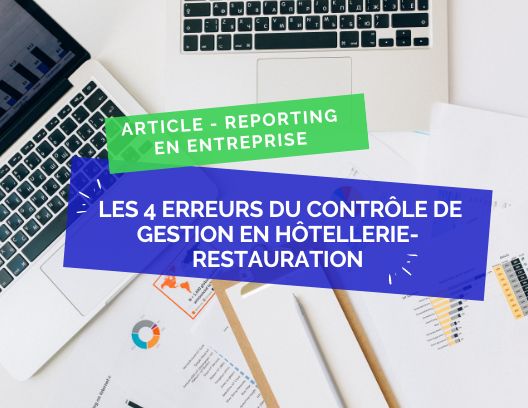The 4 mistakes in management control in the hospitality and restaurant industry
lucas-fontaine
•
Jul 8, 2024
Today, Qotid reviews the mistakes frequently made in management control in a hotel or restaurant.
In a hotel, a restaurant or any other type of business, the management controller takes on particular importance with a view to optimizing performance and reducing costs. While this exercise has its merits, it is common to make mistakes that need correcting to improve one’s activity.
So, what are the most common mistakes in management control in the hospitality sector?
Not sufficiently controlling costs and not analyzing the right indicators
In the sector, many establishments do not have management control. In this case, it is the managers who typically observe the evolution of revenue. It’s a good start, but of course, it is not sufficient to properly manage the profitability of one’s establishment(s).
The lack of information about operations is considerable and can therefore prevent the recognition of potential failures or strengths related to the activity. Thus, the decisions that ensue are not always relevant.
For instance, in restaurant management, it seems necessary to have a dashboard that includes, at a minimum, the following three economic indicators: Revenue, occupancy rate, and average ticket.
It is also important to have other indicators related to labor and restaurant inventory.
Moreover, management control in hospitality requires a very precise understanding of the costs related to the specific hotel and/or restaurant.
One must consider economic costs, closely monitor purchases/expenses, as well as hidden costs and labor costs.
In this view, a cost controller, also called a "cost controller," in direct contact with management, generally ensures the budgetary savings of the relevant establishment(s).
Not establishing budgets
In most cases, a budget must be set for 12 months as the objectives and monthly analyses will be established based on this budget. Establishing a budget for one’s hotel or restaurant thus allows for tracking costs and, importantly, detecting deviations between the set objectives and actual results in order to implement corrective actions if necessary.
Poorly monitoring indicators and changing them too often
If the establishment has set up a management control system, the question of indicators becomes crucial. They are the cornerstone of control, true tools for measuring activity. In the case of a hotel, the most commonly used indicators are the average price per room sold, the occupancy rate, revenue per available room, or revenue per customer, to name a few. At the same time, one should not neglect operational indicators, which are closer to daily activities and also allow for a finer analysis of the company's cost structure and for correcting any discrepancies. Among them, ratios like the cost of cleaning a room or the cost of raw materials for the restaurant are often used.
The management controller must therefore monitor the evolution of prices and margins in order to adapt rates and menus accordingly, as well as the occupancy rate of rooms and restaurant attendance to adjust resources accordingly.
Other indicators related to seasonality and market trends (competition) should also be considered.
Moreover, the idea of changing management indicators to improve one’s vision of the activity is sometimes tempting. However, it is important to remember that the history of an indicator is at least as important as its current value. Additionally, changing indicators too frequently hinders having a pertinent reading capable of drawing the right conclusions.

Overdoing it and only taking indicators into account
Management driven solely by indicators can have perverse effects, as this way of functioning encourages focusing on indicators rather than on the activity itself. Furthermore, it is common to forget that some indicators can sometimes compete with each other. A simplified illustration of this phenomenon is a restaurant measuring both its occupancy rate and customer satisfaction. No matter how hard the staff tries to maximize occupancy and satisfaction, they will hit a barrier. While it is easy to understand that a crowded restaurant harms the customer experience, the indicators do not highlight this. In their work Le Contrôle de Gestion (2012), Alain Burlaud and Claude Simon emphasize the tendency to favor the measurable over the non-measurable. This tendency then impacts decisions, which are de facto less rational and therefore less relevant.
Finally, management control can become time-consuming if the establishment monitors too many indicators or if its tools are underperforming. For example, management control via Excel spreadsheets, which is very common, is time-consuming and even increases the risk of errors. In this case, more resources are spent compiling and analyzing data than drawing conclusions about the decisions to be made.
It should be noted that management control software can represent a solution to these problems. On the one hand, its ease of use allows for the quick implementation of management control with the indicators of one’s choice. On the other hand, automatic data collection saves the establishment time and helps to diagnose the situation more quickly. Finally, for the more experienced users, its customization is a significant advantage. Indeed, the ability to give each employee a dashboard centered on their indicators makes their part of the work easier, faster, and less stressful.
In summary:
In the hospitality sector, management control is essential for optimizing performance and reducing costs. However, it is common to make mistakes such as not sufficiently controlling costs, not analyzing the right indicators, not establishing budgets, poorly monitoring indicators and changing them too often, and focusing solely on indicators at the expense of the activity itself.
It is important to take into account economic costs, purchases/expenses, hidden costs, and human costs, and to use key indicators such as revenue, occupancy index, and average ticket in restaurants, and average price per room sold, occupancy rate, revenue per available room, and revenue per customer in hospitality. Management control software can help solve some of these issues by facilitating data collection and allowing for customization for each employee.
F.A.Q:
1. Why is it important to control costs in the hospitality sector?
It is important to control costs in the hospitality sector because it allows for optimizing performance and reducing costs. This requires a precise understanding of the costs related to the hotel and/or restaurant in question, taking into account economic costs, purchases/expenses, hidden costs, and human costs.
2. What are the key indicators to analyze in restaurants?
The key indicators to analyze in restaurants are revenue, occupancy index, and average ticket. It is also important to have other indicators related to labor and restaurant inventory.
3. Why is it important to establish a budget for one’s hotel or restaurant?
It is important to establish a budget for one’s hotel or restaurant because it allows for tracking costs and detecting deviations between the set objectives and actual results in order to implement corrective actions if necessary. The budget should be set for 12 months as the objectives and monthly analyses will be established based on this budget.


